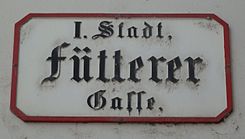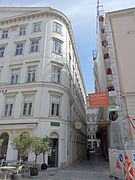Fütterergasse
| Fütterergasse | |
|---|---|
| Street in Vienna, Inner City | |
| Basic data | |
| place | Vienna, inner city |
| District | Inner City (1st District) |
| Created | in the middle ages |
| Hist. Names | Alley, as you go to Judenplatz |
| Cross streets | Wipplingerstrasse |
| Places | Judenplatz |
| Buildings | Bohemian Court Chancellery |
| use | |
| User groups | Foot traffic |
| Road design | Pedestrian zone |
| Technical specifications | |
| Street length | approx. 38 meters |
The Fütterergasse located on the 1st Viennese district , the Inner City . It is named after the job of the feed trader .
history
In the Middle Ages, Fütterergasse belonged to Vienna's Judenstadt , a closed settlement area for Jews around Judenplatz , which was separated from the rest of the city by gates. In 1421 all Jews were expelled from Vienna on the orders of Duke Albrecht V , with the houses of the Jewish town falling to the sovereign, who gave them away or sold them.
Thereupon the Fütterergasse was reckoned to the then Wildwerkerstraße , today's Wipplingerstraße (1423 occupied). Wipplingerstrasse originally had three names. From the high market to the Jordangasse it was called Bilbinger or Bülbingerstraße after a patrician family there ; from the Jordan to the Futtergasse under the game workers , while the last part to the Renngasse under the Felbern was called. The road under the Wild machine operators was 1,277 Wiltwercherstrazze (mhd. Wiltwerc = fur), a name (sometimes in wild Perger Street corrupt) to the living there Pelzer and fur traders pointed Under the contraction of the names Wildwerker- and Bülbingerstraße first emerged in the form Wülpinger- and finally Wipplingerstrasse . In 1482 there was talk of the alley, as one was going to Judenplatz . The name Fütterergasse has been in use late, since 1786 . Fütterer was the name of the traders of cattle feed in Vienna, although the feed market was located on the Neuer Markt .
Location and characteristics
The short, narrow Fütterergasse runs from Judenplatz in a north-easterly direction and connects it with Wipplingerstraße. Together with Judenplatz and other lanes adjacent to it, it forms a pedestrian zone . Here is the side of the administrative court or the house of the clothing makers' cooperative. There are also restaurants here. All buildings in Fütterergasse are under monument protection .
Buildings
No. 1: House of the clothing makers' cooperative
In the Middle Ages, the Jewish hospital was located at this point at the corner of Judenplatz and Fütterergasse. After the expulsion of the Jews there were two buildings on the left side of the street on Fütterergasse, of which the one on Wipplingerstraße was sold by the Duke, the one on Judenplatz was given away. The latter came into the possession of St. Stephen's Cathedral a hundred years later and was acquired by the Schneiderzeche in 1548. In 1684 it was referred to as the carpentry and hostel for the bourgeois tailors . The other building, however, was divided into two houses in 1592, so that there were now three buildings on this side of the street. The middle one was acquired in 1810 by the guild of bourgeois clothing makers in Vienna , and finally the third object in 1837. All three were then demolished and Ignaz Ram built the current house of the clothing makers' cooperative instead from 1837-1838.
The late classical building stands free on three sides between Judenplatz, Fütterergasse and Wipplingerstraße. Its corners are rounded. At the entrance on Fütterergasse there is a foyer that is structured by pilasters with simple palmette capitals. From here, two spiral, Doric columned stairs with original railings from the construction period lead upwards. A bronze statue depicts a tailor . It is a copy of a statue on the right side facade of the Vienna City Hall by Werner David from 1995. The building also houses a guild museum. The house is at the main address Judenplatz 10.
No. 2: Former Bohemian Court Chancellery
→ see also main article Bohemian Court Chancellery
The important baroque palace stands freely on all sides between Wipplingerstraße, Fütterergasse, Judenplatz and Jordangasse. Originally it was built in 1709–1714 by Johann Bernhard Fischer von Erlach on Wipplingerstraße. In 1751–1754, the adjacent buildings were removed and Matthias Gerl expanded the Bohemian Court Chancellery by ten window axes up to Fütterergasse and one window axis up to Jordangasse, which doubled the original main facade. It is unclear what shape the original rear facade had and what part Gerl played in the new facade facing Judenplatz. After renovations inside, Emil von Förster renewed the representative rooms from 1895–1896. Serious bomb damage in 1945 meant that Erich Boltenstern built a pedestrian passage during the reconstruction on Wipplingerstraße and the main entrance was relocated to Judenplatz.
The building always had important administrative functions. In addition to its eponymous function as the Bohemian court chancellery, it also served as the Austrian court chancellery from 1749, and then from 1848 and until 1923 as the seat of the interior ministry . In 1936 the Federal Court of Justice resided here , after 1945 the two separate courts of public law, the Constitutional and Administrative Court . Since 2012, only the administrative court has been at the site.
The facade on Fütterergasse has a broad, stepped and gabled central projection . There are layered giant pilasters and a monumental imperial eagle with Maria Theresa's coat of arms in the gable field. The base zone is banded . In the main floor Knickgiebelverdachungen can be seen on the windows and shells and navel Windowdecor in the fall fields.
The main address of the building is Judenplatz 11.
literature
- Richard Perger: streets, towers and bastions. The road network of the Vienna City in its development and its name. Franz Deuticke, Vienna 1991, ISBN 3-7005-4628-9 , p. 51.
- Felix Czeike (Ed.): Fütterergasse. In: Historisches Lexikon Wien . Volume 2, Kremayr & Scheriau, Vienna 1993, ISBN 3-218-00544-2 , p. 446 ( digitized version ).
- Bundesdenkmalamt (Ed.): Dehio-Handbuch Wien. I. District - Inner City. Berger, Horn 2003, ISBN 3-85028-366-6 , pp. 300-303. 738
Web links
Individual evidence
- ↑ Erwin Volckmann: Old commercial and industrial lanes . Memminger Brothers, Würzburg 1921, p. 56 ; Primary source: Umlauft.
Coordinates: 48 ° 12 ′ 42.7 " N , 16 ° 22 ′ 11.7" E





